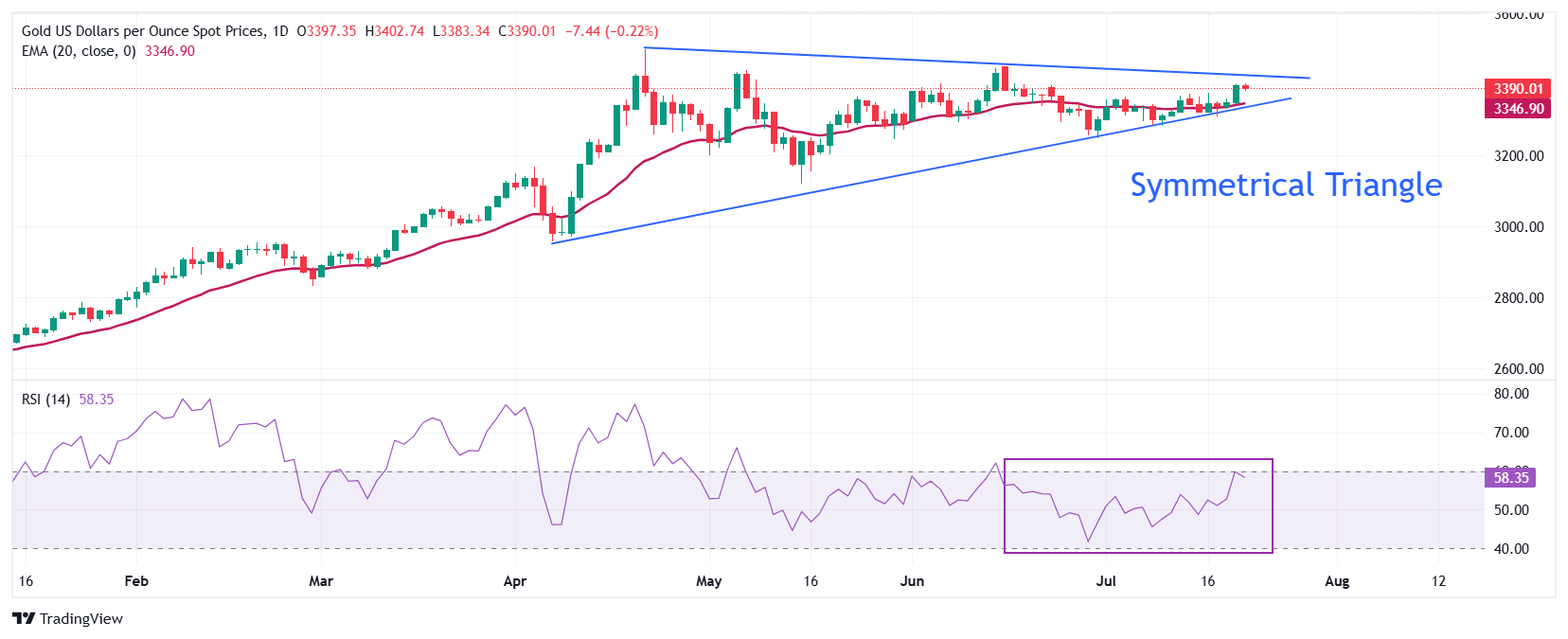Gold Price Forecast: XAU/USD strives to break above $3,400 amid US-EU trade tensions
- Gold price eyes a decisive break above $3,400 amid trade tensions between the US and the EU.
- Germany vows countermeasures as US President Trump threatens higher baseline tariff rate.
- Traders pare Fed dovish bets as the impact of Trump’s tariffs has started flowing to the economy.
Gold price (XAU/USD) ticks down to near $3,385 during the European trading session on Tuesday. Still, the precious metal trades close to an over-a-month high around $3,400. The yellow metal is broadly firm as trade tensions between the United States (US) and the European Union (EU) have escalated.
Trade worries between both economies have increased as the EU prepares new economic countermeasures to offset the impact of tariffs threatened by US President Donald Trump.
Over the weekend, a report from the Wall Street Journal (WSJ) showed that Trump ha demanded a higher baseline tariff rate between 15% and 20%, higher from 10% previously stated, which has upended the EU’s plans that was strategizing trade terms on 10% baseline tariff rate.
In retaliation, Germany joined France and its other European peers in pressing a tougher stance on the US. “If they want war, they will get war,” a German official said, WSJ reported.
The absence of a deal confirmation by the two before the August tariff deadline will further escalate trade tensions, a scenario that could upheaval global trade flow.
Theoretically, heightened global tensions improve demand for safe-haven assets, such as Gold.
Meanwhile, growing expectations that the Federal Reserve (Fed) could leave interest rates steady in the September policy meeting would limit the upside in the Gold price.
According to the CME FedWatch tool, the probability for the Fed to reduce borrowing rates in the September policy meeting has also reduced to 58.3% from 69.6% seen a month ago. Traders pare Fed dovish bets after the latest Consumer Price Index (CPI) report showed that prices of products that are largely imported in the US have increased.
Fed’s restrictive monetary policy stance bodes poorly for non-yielding assets, such as Gold.
Gold technical analysis
Gold price trades in a Symmetrical Triangle formation on a daily timeframe, which indicates a volatility contraction. The upward-sloping trendline of the above-mentioned chart pattern is placed from the May 15 low of $3,120.83, while its downward-sloping border is plotted from the April 22 high around $3,500
The 20-day Exponential Moving Average (EMA) around $3,347 acts as a key support area for the Gold price.
The 14-day Relative Strength Index (RSI) rises to near 60.00. A fresh bullish momentum would emerge if the RSI breaks above that level.
Looking up, the Gold price will enter in an unchartered territory if it breaks above the psychological level of $3,500 decisively. Potential resistances would be $3,550 and $3,600.
Alternatively, the Gold price would fall towards the round-level support of $3,200 and the May 15 low at $3,121, if it breaks below the May 29 low of $3,245
Gold daily chart

steady
Gold FAQs
Gold has played a key role in human’s history as it has been widely used as a store of value and medium of exchange. Currently, apart from its shine and usage for jewelry, the precious metal is widely seen as a safe-haven asset, meaning that it is considered a good investment during turbulent times. Gold is also widely seen as a hedge against inflation and against depreciating currencies as it doesn’t rely on any specific issuer or government.
Central banks are the biggest Gold holders. In their aim to support their currencies in turbulent times, central banks tend to diversify their reserves and buy Gold to improve the perceived strength of the economy and the currency. High Gold reserves can be a source of trust for a country’s solvency. Central banks added 1,136 tonnes of Gold worth around $70 billion to their reserves in 2022, according to data from the World Gold Council. This is the highest yearly purchase since records began. Central banks from emerging economies such as China, India and Turkey are quickly increasing their Gold reserves.
Gold has an inverse correlation with the US Dollar and US Treasuries, which are both major reserve and safe-haven assets. When the Dollar depreciates, Gold tends to rise, enabling investors and central banks to diversify their assets in turbulent times. Gold is also inversely correlated with risk assets. A rally in the stock market tends to weaken Gold price, while sell-offs in riskier markets tend to favor the precious metal.
The price can move due to a wide range of factors. Geopolitical instability or fears of a deep recession can quickly make Gold price escalate due to its safe-haven status. As a yield-less asset, Gold tends to rise with lower interest rates, while higher cost of money usually weighs down on the yellow metal. Still, most moves depend on how the US Dollar (USD) behaves as the asset is priced in dollars (XAU/USD). A strong Dollar tends to keep the price of Gold controlled, whereas a weaker Dollar is likely to push Gold prices up.

